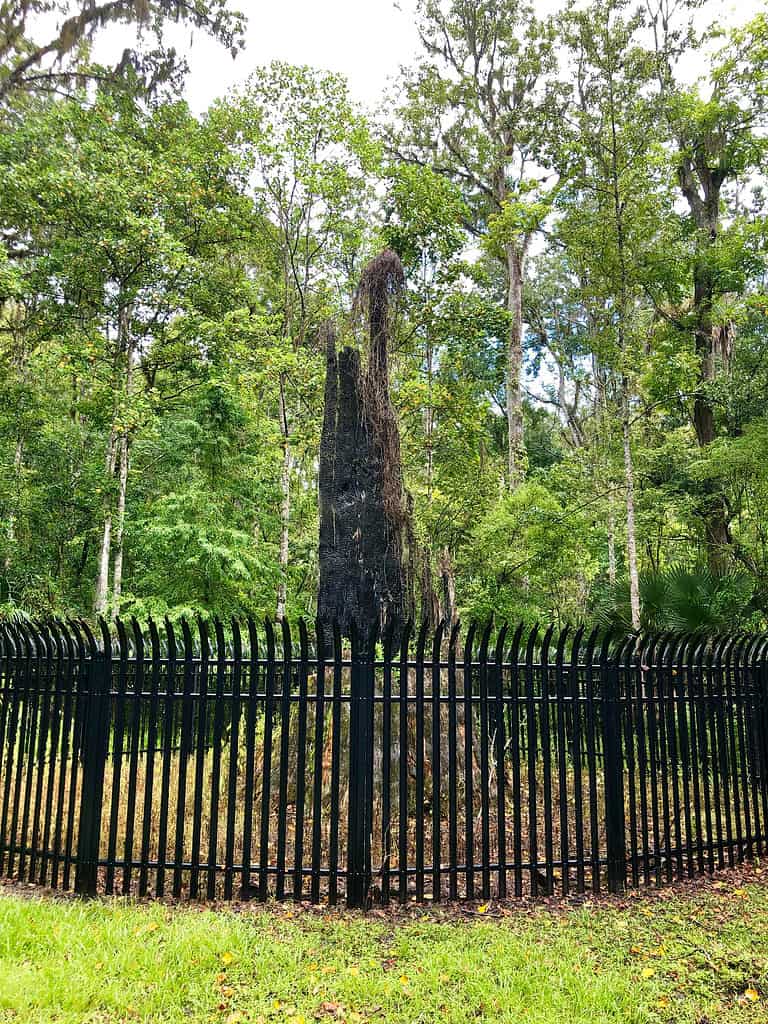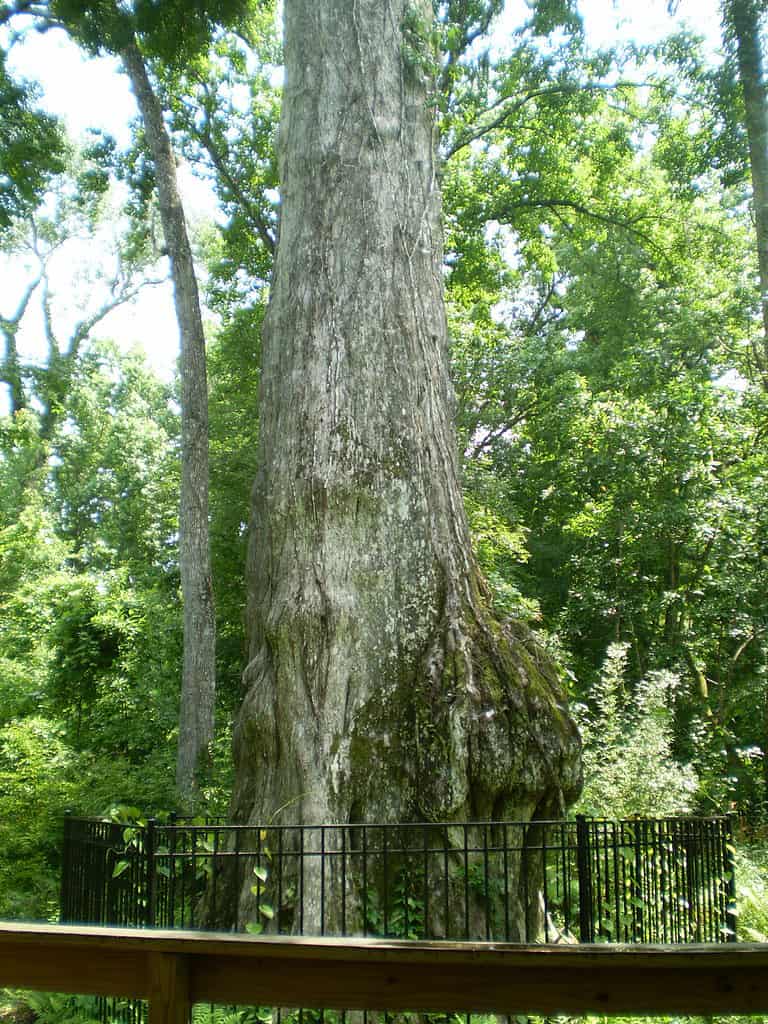Florida may not be known much for their trees in the way that states like California are known for their redwoods. That being said, there are some pretty massive trees in the Sunshine State. Let’s take a look at the tallest tree in Florida, as well as a few other interesting trees from the state.
The Tallest Tree in Florida
A wide variety of unique trees can be found in the gorgeous state of Florida, which is renowned for its beautiful scenery and varied flora. A particularly impressive monster of a tree can be found among these arboreal wonders: an 84-foot bald cypress (also known as Taxodium distichum), the tallest tree in Florida. This extraordinary specimen embodies the strength and beauty of the state’s natural history, rising upward with grace and grandeur.
This enormous bald cypress enchants everyone who sees it. It is located in a remote wetland in Hamilton County, Florida, one of the state’s protected regions. It is the tallest tree in the state, rising dramatically over the surrounding forest. Its huge, ancient trunk shows the signs of centuries past.
This bald cypress’s 84-foot height is proof of how adaptable and resilient the species is. Its 557-inch circumference is equally astounding. At 49 feet, its crown spread is likewise massive.

The Senator (pictured) was formerly one of the biggest and oldest bald cypress trees in the United States until it was unintentionally destroyed by fire.
©Maily Nguyen/Shutterstock.com
The Beauty and Adaptability of Bald Cypress Trees
Bald cypress trees are well known for their propensity to flourish in wetlands, frequently remaining submerged for lengthy periods of time. They are skilled at attaching themselves and locating food in the difficult environment of swamps and marshes because of their sophisticated root systems.
The bald cypress’s rich green foliage adds to its attractiveness. The subtle contrast between its fluffy, needle-like leaves and the imposing trunk’s power and sturdiness is striking. The leaves of this extraordinary tree change into a magnificent variety of blazing orange, red, and gold in the fall, creating a stunning reflection on the quiet waters below.
This proud representative of Florida’s natural history has seen numerous generations pass by and the surrounding environment changes over time. Numerous animal species, including birds, mammals, and amphibians, have found refuge and protection in its branches. The bald cypress serves as a live example of how the environment is interrelated and how important trees are to maintaining biodiversity throughout Florida.
Protecting the Tallest Tree in Florida
This gorgeous specimen is being protected through conservation efforts. It serves as a reminder of the need of protecting and valuing Florida’s distinctive ecosystems. It serves as a reminder of the fine line that must be drawn between the necessity for further human progress and the preservation of nature’s wonders for future generations.
One is humbled and motivated after standing in the shadow of the largest tree in Florida. It makes us wonder and become more inquisitive, inspiring us to learn more about the natural world’s secrets.
Where is the Largest Live Oak Tree in Florida?
The Cellon Oak, located north of Gainesville, is the largest living oak tree (Quercus spp.) in Florida. It is capable of shading a massive area a space that other oak trees simply could never manage at nearly 30 feet in circumference.
In honor of its former owner, Ralph W. Cellon, the Cellon Live Oak is located in Cellon Oak Park. The oak tree is 29 feet in circumference, 79 feet in height, and 160 feet in crown spread. It’s important to keep in mind that the numbers are around two decades old, indicating that the oak has probably grown a bit since then. Steel wires are threaded through the tree, almost like vines, to act as lightning arrestors. Some of its limbs, which are denser than most whole trees in Florida, have been sawed off to lower the chance of rot. This tree is truly an incredible sight!
As part of a repossession process to protect the tree and grant public access, the United States Small Business Administration transferred the park to Alachua County. It’s a beautiful location for modest outdoor weddings and family portraits in the park, especially if you can get a shot of the Cellon Oak!
What is the Tallest Pine Tree in Florida?
There are a few massive pine trees that can be found in the state of Florida. According to official records, the largest brown pine tree (Podocarpus grayae) in Florida is an Emeritus Florida Champion that stands at 23 feet tall with a circumference of 27 feet and a crown spread of 17 feet. There are two Lolblolly pines (Pinus taeda) that are considered the largest in the state. One is a Marion County tree that is 111 feet tall, 156 feet in circumference, and has a 52.5-foot crown spread. The other is a Nassau specimen that is 104 feet tall, 174 feet in circumference, and has a 72-foot crown spread.
Where is the Oldest Living Tree in Florida?
Lady Liberty is a famous bald cypress tree that is 2,000 years old. The tree truly serves as a living example of fortitude and unmatched beauty in the middle of Florida. This ancient arboreal marvel has attracted the attention of both tourists and residents because of its astounding size, mesmerizing presence, and current conservation efforts.
Lady Liberty is a magnificent behemoth among trees and may be seen at Longwood’s Big Tree Park. This magnificent bald cypress captures respect and attention with its amazing height of over 82 feet and girth of about 34 feet. The tree’s gnarled, worn trunk shows the ravages of time, and its languid branches provide a beautiful silhouette against the sky.
Lady Liberty’s heritage has been preserved in large part because of conservation initiatives. This old tree has been the focus of continual maintenance and conservation due to its value as the oldest tree in Florida. The Seminole County Chamber of Commerce acquired the property where Lady Liberty now stands in 1929 and created Big Tree Park as a refuge for this magnificent bald cypress. Over time, precautions have been taken to guarantee the health of the tree, including the placement of barriers and signage to deter human contact.

Lady Liberty (pictured) is a beloved tree that has been estimated to be over 2,000 years old.
©EvelynGiggles / Flickr – License
Where is Lady Liberty Located on a Map?
In Big Tree Park, Longwood, Florida, stands Lady Liberty, an ancient bald cypress (Taxodium distichum). Remarkably, this tree is over 2,000 years old and stands just 40 feet away from the former location of another iconic tree, The Senator, a 3,500-year-old Bald Cypress that tragically burned down on January 16, 2012.
Here is Lady Liberty on a map:
A Cherished Old Tree
Lady Liberty’s longevity is proof of the strength of bald cypress trees. This old tree has witnessed the passage of time and changes in its habitat for two millennia. Its durability serves as a reminder of the complex interaction between history and nature.
Coincidentally, Lady Liberty is just 40 feet from the former site of the Senator, a 3,500-year-old bald cypress that was tragically destroyed by a fire on January 16th, 2012. Since the Senator’s death, Big Tree Park has paid more attention to and taken precautions to secure the preservation of its only remaining giant.
Visiting Lady Liberty
A tranquil and uplifting experience can be had by visiting Lady Liberty. The tree’s placement in Big Tree Park offers a serene area for thought and introspection. People can wander through the park, taking in the scenic surroundings and Lady Liberty’s legendary presence. Just as well, the park has signs and exhibits that enlighten visitors about the value of conservation and the significance of this historic tree.
Lady Liberty, as well as the other trees mentioned in this article, is a living illustration of the force of nature and the value of preservation. They are beloved monuments in the state due to their astounding size, old age, and continuing conservation efforts. Visitors of these trees can be reminded of the significance and continuing beauty of Florida’s natural heritage as they take in their massive, ancient shapes.
The photo featured at the top of this post is © anthony heflin/Shutterstock.com
Thank you for reading! Have some feedback for us? Contact the AZ Animals editorial team.






